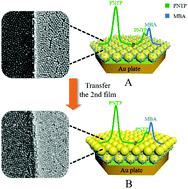Our official English website, www.x-mol.net, welcomes your feedback! (Note: you will need to create a separate account there.)
The moveable “hot spots” effect in an Au nanoparticles–Au plate coupled system
Nanoscale ( IF 6.7 ) Pub Date : 2020-11-11 , DOI: 10.1039/d0nr06997c Ying Sun 1, 2, 3, 4, 5 , Chenjie Zhang 1, 2, 3, 4, 5 , Yaxian Yuan 1, 2, 3, 4, 5 , Minmin Xu 1, 2, 3, 4, 5 , Jianlin Yao 1, 2, 3, 4, 5
Nanoscale ( IF 6.7 ) Pub Date : 2020-11-11 , DOI: 10.1039/d0nr06997c Ying Sun 1, 2, 3, 4, 5 , Chenjie Zhang 1, 2, 3, 4, 5 , Yaxian Yuan 1, 2, 3, 4, 5 , Minmin Xu 1, 2, 3, 4, 5 , Jianlin Yao 1, 2, 3, 4, 5
Affiliation

|
Surface-enhanced Raman spectroscopy (SERS) is mainly contributed by “hot spots”. Due to the huge electromagnetic enhancement, “hot spots” have wide applications in surface analysis and surface catalysis. The in-depth research on the “hot spots” effect is conducive to understanding SERS enhancement mechanisms and designing substrates with high enhancement. At present, the investigation on the “hot spots” effect is mainly based on theoretical simulation and simple experimental models. However, little attention has been paid to the SERS substrates with practical applications. The main reason is that it is difficult to construct a suitable coupled model with great uniformity and sensitivity, which led to the lack of comparability of SERS intensities from different spots or substrates. In this work, Au nanoparticle mono-/bi-layer films coupled with Au single-crystal plate systems were constructed to investigate the distribution and transformation of “hot spots” dependent on the excitation wavelength by a single or dual probe-modified strategy, in which one or two types of molecules with distinct characteristic peaks were modified in different enhanced gaps. The results demonstrated that the wavelength that drove the transformation of the coupling mode from the “particle–particle” mode to the “particle–surface” mode was around 638 nm in the Au nanoparticle monolayer film (Au MLF) covered Au plate system. As the second naked Au MLF was transferred onto the first Au MLF, “hot spots” were transferred to the “particle–particle” gap between the upper and lower Au MLFs with a 638 nm laser as the excitation line. This work offers a novel avenue to investigate the “hot spots” effect in the complex multidimensional nanostructures, which is beneficial for the development of theoretical research and practical applications of SERS.
中文翻译:

Au纳米颗粒-Au板耦合系统中的可移动“热点”效应
表面增强拉曼光谱(SERS)主要由“热点”贡献。由于巨大的电磁增强作用,“热点”在表面分析和表面催化中具有广泛的应用。对“热点”效应的深入研究,有助于理解SERS增强机理,并设计出具有高增强作用的基材。目前,对“热点”效应的研究主要基于理论模拟和简单的实验模型。然而,在实际应用中很少关注SERS基材。主要原因是难以构建具有高度均匀性和灵敏度的合适的耦合模型,这导致缺乏来自不同斑点或底物的SERS强度的可比性。在这项工作中 构造了与单晶板系统耦合的金纳米颗粒单/双层膜,以通过单探针或双探针修饰策略研究取决于激发波长的“热点”的分布和转化,其中一个或两个具有不同特征峰的分子类型在不同的增强间隙中被修饰。结果表明,在覆盖Au纳米颗粒单层膜(Au MLF)的Au板系统中,驱动耦合模式从“颗粒-颗粒”模式转换为“颗粒-表面”模式的波长约为638 nm。当第二个裸金Au MLF转移到第一个Au MLF上时,以638 nm激光作为激发线,将“热点”转移到上下Au MLF之间的“粒子-颗粒”间隙。
更新日期:2020-11-25
中文翻译:

Au纳米颗粒-Au板耦合系统中的可移动“热点”效应
表面增强拉曼光谱(SERS)主要由“热点”贡献。由于巨大的电磁增强作用,“热点”在表面分析和表面催化中具有广泛的应用。对“热点”效应的深入研究,有助于理解SERS增强机理,并设计出具有高增强作用的基材。目前,对“热点”效应的研究主要基于理论模拟和简单的实验模型。然而,在实际应用中很少关注SERS基材。主要原因是难以构建具有高度均匀性和灵敏度的合适的耦合模型,这导致缺乏来自不同斑点或底物的SERS强度的可比性。在这项工作中 构造了与单晶板系统耦合的金纳米颗粒单/双层膜,以通过单探针或双探针修饰策略研究取决于激发波长的“热点”的分布和转化,其中一个或两个具有不同特征峰的分子类型在不同的增强间隙中被修饰。结果表明,在覆盖Au纳米颗粒单层膜(Au MLF)的Au板系统中,驱动耦合模式从“颗粒-颗粒”模式转换为“颗粒-表面”模式的波长约为638 nm。当第二个裸金Au MLF转移到第一个Au MLF上时,以638 nm激光作为激发线,将“热点”转移到上下Au MLF之间的“粒子-颗粒”间隙。



























 京公网安备 11010802027423号
京公网安备 11010802027423号